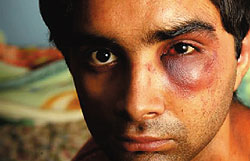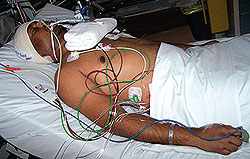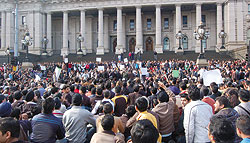The Australian experience shows that perception of the Indian community and the Government of India has been that the recent incidents of attack on Indian students was racially motivated. It has resulted in Australian Government stepping in to assure the Indian community that the Government and the criminal justice system will do what it can to ensure the safety of the Indian students. Likewise, the Indian Government and its High Commission in Canberra have assured the Indian students that it will do what it can to assist them. The Indian Government has given similar assurances to its NRIs in the Gulf States where there have been allegations of some Indian nationals being forced to work in conditions akin to slavery.
 The Australian PM, Kevin Rudd stated that he was "disgusted" and "deeply disturbed" by the attack on the Indian students. In bilateral talks with Kevin Rudd, Dr Manmohan Singh conveyed his concern. It led to a high powered Australian Government officials coming to India to placate Indians, particularly the international students and their families. Tertiary education is big business in Australia, where approximately 100,000 Indian students attend colleges, universities and technical institutions.
The Australian PM, Kevin Rudd stated that he was "disgusted" and "deeply disturbed" by the attack on the Indian students. In bilateral talks with Kevin Rudd, Dr Manmohan Singh conveyed his concern. It led to a high powered Australian Government officials coming to India to placate Indians, particularly the international students and their families. Tertiary education is big business in Australia, where approximately 100,000 Indian students attend colleges, universities and technical institutions.
 Until the perpetrators of the cowardly attacks are investigated and brought to justice, it is difficult to know for certain whether in fact some or all of these attacks were racially motivated. However, given the number and frequency of these attacks, one understandably perceives these attacks as racially motivated. Indians understandably feel that there are too many such incidents within a relatively short period to be explained away as random opportunistic attacks. Only time will tell. Once investigations are completed will we know which, if any, of such incidences, were racially motivated. The Indian Government has relayed its concerns once again to the Australian Government after Nitin Garg was fatally stabbed.
Until the perpetrators of the cowardly attacks are investigated and brought to justice, it is difficult to know for certain whether in fact some or all of these attacks were racially motivated. However, given the number and frequency of these attacks, one understandably perceives these attacks as racially motivated. Indians understandably feel that there are too many such incidents within a relatively short period to be explained away as random opportunistic attacks. Only time will tell. Once investigations are completed will we know which, if any, of such incidences, were racially motivated. The Indian Government has relayed its concerns once again to the Australian Government after Nitin Garg was fatally stabbed.
|
Indians understandably feel that there are too many such incidents within a relatively short period to be explained away as random opportunistic attacks
|
 The state and judicial response to racially aggravated crime, includes legislation such as creation of discrete hate crime offences, sentencing which treats hate crime as an aggravating factor, proper investigative resources, for example properly trained police force which is sensitive to the cultural/religious/gender values of the minority groups, and an independent judiciary which deals with such issues in a timely fashion and, in appropriate cases, sentences offenders with a view to denouncing and deterring hate crime against minority groups. Sentencing may also take into account the need to facilitate rehabilitative counseling and programmes with a view to mitigating re-offending. The state and judicial response to racially aggravated crime, includes legislation such as creation of discrete hate crime offences, sentencing which treats hate crime as an aggravating factor, proper investigative resources, for example properly trained police force which is sensitive to the cultural/religious/gender values of the minority groups, and an independent judiciary which deals with such issues in a timely fashion and, in appropriate cases, sentences offenders with a view to denouncing and deterring hate crime against minority groups. Sentencing may also take into account the need to facilitate rehabilitative counseling and programmes with a view to mitigating re-offending.
It is also critical that PIOs/NRIs and, in particular, international students, are briefed adequately on what to expect in a foreign environment. In this regard the Global Organization of People of Indian Origin (GOPIO) can play a pivotal role in facilitating programmes for new immigrants and international students. Even more importantly, GOPIO can also facilitate and assist in providing victims with information on how they may access various facilities available in the host nation. Whilst I fully appreciate that it would be beyond GOPIO resources to actually provide such facilities, I have no doubt that it would be within its resources to provide a directory of services available, and ultimately, the services as well.
|
Our community members are generally in the frontline businesses such as dairies, service station operators, bank officers and retail businesses |
 At the outset, I wish to observe that the term "hate crime" does not necessarily include opportunistic crime. Often, PIOs/NRIs and other minority groups are victims of opportunistic crimes. Our community members are generally in the frontline businesses such as dairies, service station operators, bank officers and retail businesses. Armed robberies of such premises are generally committed not because the operators are PIOs/NRIs but because such businesses carry cash and have valuables which burglars and armed robbers seek to loot. Our people are often victims of such offending. However, such crime does not constitute hate crime, even though the victims often are NRIs/PIOs as well as others, including Asians generally. It is important for us to educate our community on ways to mitigate being targets. At the outset, I wish to observe that the term "hate crime" does not necessarily include opportunistic crime. Often, PIOs/NRIs and other minority groups are victims of opportunistic crimes. Our community members are generally in the frontline businesses such as dairies, service station operators, bank officers and retail businesses. Armed robberies of such premises are generally committed not because the operators are PIOs/NRIs but because such businesses carry cash and have valuables which burglars and armed robbers seek to loot. Our people are often victims of such offending. However, such crime does not constitute hate crime, even though the victims often are NRIs/PIOs as well as others, including Asians generally. It is important for us to educate our community on ways to mitigate being targets.
 Before I conclude, I wish to set out a non-exhaustive list of tips for NRIs/PIOs/International students, particularly in Australia:
Before I conclude, I wish to set out a non-exhaustive list of tips for NRIs/PIOs/International students, particularly in Australia:
∑ Without limiting joys of life, keep a low profile, that is, do not show off wealth, for instance I-Pods / state-of-art mobile / other equipment, fashion branded shoes / clothing. These attract opportunistic crime.
∑ Not to be alone or even in groups in known trouble spots eg in parks, red-light districts, especially at nights.
∑ Always carry an ID on self. In case of attack/serious injury, police should be able to easily identify the victim and be able to contact the family.
∑ It may prove expensive but seek help of senior members of our community in locating accommodation in safe areas, albeit crime takes place even in safe areas. At least, it may mitigate the chances of being attacked.
∑ Always tell a family member or a friend/flatmate where you are going with phone contact in cases of emergency, especially during the night.
∑ Learn about the dos and doníts of the local area.
|